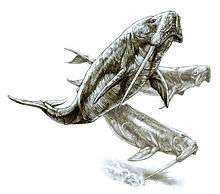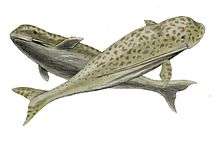Odobenocetops
| Odobenocetops Temporal range: Late Miocene–Pliocene | |
|---|---|
| | |
| Skull of a male O. Leptodon | |
| Scientific classification | |
| Kingdom: | Animalia |
| Phylum: | Chordata |
| Clade: | Synapsida |
| Class: | Mammalia |
| Order: | Artiodactyla |
| Infraorder: | Cetacea |
| Superfamily: | Delphinoidea |
| Family: | †Odobenocetopsidae Muizon 1993 |
| Genus: | †Odobenocetops Muizon 1993 |
| Species[1] | |
| |
Odobenocetops (/ˌɒdəbiˈnɒsᵻtɒps/) was a small toothed whale known from Peru and Chile, they are restricted to Neogene (mostly Miocene), they were believed to be somewhat extinct at the Pliocene. [1][2] It had two tusks, and, in some fossils, one tusk was longer than the other.
Phylogeny
Odobenocetops can be identified as a cetacean based on several features unique to this order:[3]
- The presence of large air sinuses in the auditory region connected to large pterygoid sinuses.
- The large supraorbital process of the frontal bone overhanging the orbital region.
- Narial fossae opening dorsally (thought not at the apex of the skull like in other cetaceans.)
- The absence of a true cribriform plate (a bony blade separating the nares). In Odobenocetops, a group of foramina in this plate allows the passage of olfactory nerves connected to the small olfactory lobes in the brain. In other cetaceans, the olfactory nerves are similarly present but strongly reduced.
- The elbow joint is immobile, as shown by a single partial forelimb.
Murakami et al. 2014 placed Odobenocetopssidae in a large clade together with Phocoenidae (porpoises), Monodontidae (narwhal and beluga), and Albireonidae (extinct porpoise-like). This clade originated in the Pacific Ocean in the Langhian (15-13 ma) and diversified from there during the Serravallian and Tortonian (13-7 ma).[4] According to the morphological analysis of Murakami et al., Odobenocetops belongs to the middle Pliocene.[5]
Etymology
The generic name Odobenocetops comes from Greek odon, "tooth", and baino, "walk" and Latin cetus, "whale", and ops, "like", meaning "cetacean that seems to walk on its teeth" but is also referring to the similarity to the walrus (Odobenus).[6]
Description

Odobenocetops was an early member of the dolphin superfamily, more closely related to narwhals than dolphins, with tusks projecting towards the rear of its body. It measured about 2.1 m (6.9 ft) long[7] and weighted between 150 and 650 kg. Its neck articulations show that it was very flexible, being able to turn its head over 90 degrees. This, coupled with its broad snout, similar to that of a walrus, suggests that it was a bottom feeder, searching for mollusks and sucking them out of their shells with a powerful tongue.
The rostrum of Odobenocetops is short and rounded, in contrast to the elongated rostra found in other cetaceans. The bony nares are located near the tip of the skull, in contrast to the blowholes of whales and dolphins located on the top of the skull. The palate is arched and toothless like in walruses. The eye-sockets are oriented upwards and sideways, and not laterally like in other dolphins. In other odontocetes, parts of the frontal and maxillae cover the temporal fossae. In Odobenocetops, these bones are reduced and narrowed so that the temporal fossae is open dorsally. The periotic and tympanic bones are similar to those in other dolphins. No mandible has been recovered and only few postcranial elements. The body length has been estimated to 3–4 metres (9.8–13.1 ft). [8]
The holotype of the younger species O. leptodon was found with both tusks in situ, the right one 1.35 metres (4 ft 5 in) long, the erupted portion 1.07 metres (3 ft 6 in), the left tusk was only 25 centimetres (9.8 in) but a wear facet indicates that it was erupted. The skull of O. leptodon differs from that of O. peruvianus in the absence of a premaxillary foramina and the presence of a dorsal fossa (shallow depression) on the premaxilla. This fossa suggests the presence of a melon in O. leptodon, an organ either absent or strongly reduced in O. peruvianus. On the other hand, the orbit in O. leptodon has an anterior edge that is only slightly concave, whereas it is deeply notched in O. peruvianus which suggests that O. peruvianus used binocular vision.[9]
Analyses of neck bones of both species suggest that Odobenocetops swam with its head bent ventrally, which would have brought the long right tusk in males in parallel to the body and allowed O. leptodon good use of its binocular vision.[9]
Tusks

Perhaps the most striking discovery was that of a male O. leptodon skull with a tusk significantly longer than the other. On the right side of the body, the tusk was often 1.2 m (3.9 ft) long, but on the left it could only grow up to 25 centimetres (9.8 in) long.[7] Being the only male O. leptodon skull known, it is not safe to say it was present in all male individuals of the species. Being too brittle, the tusk was probably held parallel to the body. It might have been used to search out food, or as a sensory organ like narwhal tusks. Even though they are closely related to these primitive whales, the tusks were gained by convergent evolution. Tim Haines thought that the tusks could be used during the mating season in jousts over females.[7]
The abstract of Muizon 1993 helps to explain why this is so:
| “ |
The recent discovery in the Southern Hemisphere (15.5 °S) of a walrus-like skull of a toothed whale (odontocete) from the Pisco Formation of southern Peru presents a startling example of convergence and specialization unprecedented among cetaceans. In contrast to other toothed whales, Odobenocetops peruvianus has no elongated rostrum but has large, ventrally directed premaxillary alveolar processes housing asymmetrical tusks. The dorsally facing orbits indicate the possibility of dorsal binocular vision which could compensate for the absence of the melon, a rostral organ involved in echolocation. Strong muscle scars on the anterior edge of the premaxillae suggest the presence of a powerful upper lip. It is this feature, together with the morphology of the deep vaulted palate devoid of maxillary teeth, that enables us to hypothesize a convergent feeding adaptation with the walrus which feeds mainly on thin-shelled bivalve molluscs, sucking out the foot and/or siphon and ejecting the shell. The structure of the face and basicranium indicates it was a delphinoid cetacean, probably related to the living beluga and narwhal (Monodontidae).[10] |
” |
The occurrence of tusks in Odobenocetops is a convergence with narwhals. However, in narwhals the male tusk is implanted in the left maxilla, whereas in Odobenocetops it is implanted in the right premaxilla. The tusks in these two genera are therefore not homologous.[11]
See also
References
Notes
- 1 2 "Odobenocetops". Fossilworks. Retrieved 6 December 2014.
- ↑ "Sacaco (SAO horizon) (Miocene of Peru)". Fossilworks. Retrieved 6 December 2014.
"Sud-Sacaco West (SAS) horizon) (Miocene of Peru)". Fossilworks. Retrieved 6 December 2014.
"Cerro Ballena (Miocene to of Chile)". Fossilworks. Retrieved 6 December 2014. - ↑ Muizon, Domning & Ketten 2002, pp. 241–243
- ↑ Murakami et al. 2014, p. 504
- ↑ Murakami et al. 2014, Figures 10 & 11
- ↑ Muizon, Domning & Ketten 2002, p. 224
- 1 2 3 Haines 2007
- ↑ Muizon 2008, Descriptive anatomy, p. 979
- 1 2 Muizon, Domning & Ketten 2002, Addendum, pp. 257–258
- ↑ Muizon 1993, Abstract
- ↑ Muizon, Domning & Ketten 2002, pp. 244–245
Sources
- Berta, Annalisa; Sumich, James L.; Kovacs, Kit M. (2005). Marine Mammals: Evolutionary Biology (2nd ed.). Academic Press.
- Haines, T.; Chambers, P. (2007). The Complete Guide to Prehistoric Life. Italy: Firefly Books Ltd. pp. 186–187. ISBN 1-55407-181-X.
- Muizon, C. (1993). "Walrus-like feeding adaptation in a new cetacean from the Pliocene of Peru". Nature. 365: 745–748. doi:10.1038/365745a0.
- Muizon, C. (2008). "Odobenocetops". In Perrin, W. F.; Würsig, B.; Thewissen, J. G. M. Encyclopedia of Marine Mammals (2nd ed.). Academic Press. pp. 797–799. ISBN 978-0-12-373553-9.
- Muizon, C.; Domning, D. P.; Ketten, D. R. (2002). "(Odobenocetops peruvianus), the walrus-convergent delphinoid (mammalia: cetacea) from the early pliocene of Peru". Smithsonian Contributions to Paleobiology. 93: 223–261. Retrieved 6 December 2014.
- Muizon, C.; Domning, D.; Parrish, M. (1999). "Dimorphic tusks and adaptive strategies in a new species of walrus-like dolphin (Odobenocetopsidae) from the Pliocene of Peru [Défenses dimorphiques et stratégies adaptatives chez une nouvelle espèce de dauphin convergent vers les morses (Odobenocetopsidae) du Pliocène du Pérou]". Comptes Rendus de l'Académie des Sciences - Series IIA - Earth and Planetary Science. 329 (6): 449–455. doi:10.1016/S1251-8050(00)80070-1.
- Murakami, M.; Shimada, C.; Hikidad, Y.; Soedae; Hirano, H. (2014). "Eodelphis kabatensis, a new name for the oldest true dolphin Stenella kabatensis Horikawa, 1977 (Cetacea, Odontoceti, Delphinidae), from the upper Miocene of Japan, and the phylogeny and paleobiogeography of Delphinoidea". Journal of Vertebrate Paleontology. 34 (3): 491–511. doi:10.1080/02724634.2013.816720. Lay summary (6 December 2014).
External links
- 3D model of the type specimen of Odobenocetops: "Walrus whale (Odobenocetops)". Smithsonian X 3D. Retrieved 6 December 2014.